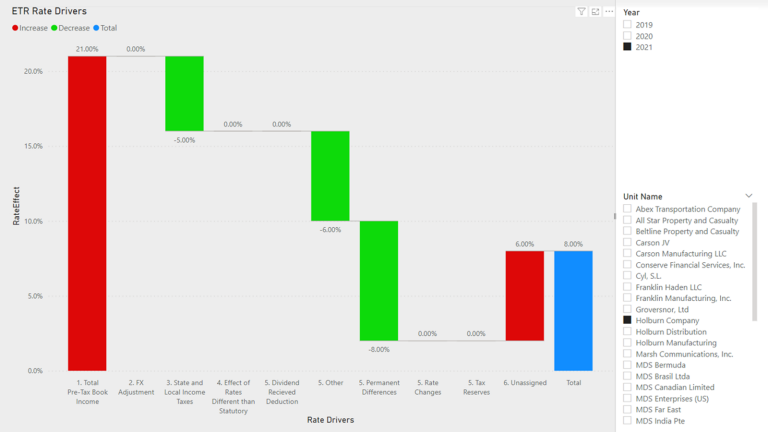Tips on data management for tax provisioning, using technology to keep up with regulatory changes like OBBBA, and more.
Corporate tax teams are facing an array of risks, new and old, that complicate their ability to deliver an accurate and defendable tax provision within an ever-shrinking financial close window. These liabilities include new flexible work models; challenges accessing tax data and streamlining workflows; and regulatory developments, including global minimum tax, among other concerns. The good news is that corporate tax provision software can help your tax team mitigate these risks without requiring you to outsource or use contingent staff — so you can keep your processes in-house and maintain full control.
Jump to ↓
What challenges does your tax department face?
Keeping up with regulatory changes
Use corporate tax provision software to mitigate key risks
Gain the capabilities of a robust corporate tax provision software solution
What challenges does your tax department face?
Tax departments today operate in an increasingly complex landscape where manual processes create significant exposure to costly errors and compliance failures. When your team relies on spreadsheets and disconnected systems to calculate provisions, track changes in tax law, or manage multiple jurisdictions, the margin for error grows exponentially. A single miscalculation or overlooked regulation can trigger penalties, interest charges, and unwanted scrutiny from tax authorities. These risks multiply when staff turnover occurs, leaving critical institutional knowledge walking out the door with departing employees.
The pressure to meet tight reporting deadlines while ensuring accuracy puts tax professionals in an impossible position. Without proper controls and automated workflows, teams often find themselves scrambling to verify calculations at the last minute, increasing the likelihood of mistakes slipping through. Add to this the challenge of staying current with constantly evolving tax regulations across multiple jurisdictions, and it becomes clear why many tax departments struggle to maintain confidence in their provision accuracy.
Perhaps most concerning is the lack of visibility into potential issues until it’s too late. When processes aren’t standardized and documentation is scattered across various files and systems, identifying and addressing risks becomes a reactive exercise rather than a proactive strategy. This reactive approach not only increases financial exposure but also consumes valuable resources that could be better spent on strategic tax planning and optimization.
Under these circumstances, it is prudent to make sure the right pieces are in place to handle today’s (and tomorrow’s) challenges. Tax departments with strong, adaptable workflow controls and effective tech solutions in place are set to succeed in this dynamic environment. Let’s explore how to do that below.
How to make use of clean data
Easy access to clean data is the key to meeting these challenges, and corporate tax provision software can deliver. With the right tax software, you can collect data once, aggregate it, and format it for use in all of your tax processes. Because it’s stored in a single data repository, your data is easy to use and share across functions. For example, digital data collection and workflows can analyze record summaries in seconds, giving you a repeatable process and data that’s ready to be used for compliance and reporting.
With tax data management software, you can standardize existing tax packages and workpapers while adhering to key controls. This software allows you to validate data and use automation to flow that data into your chosen tax applications at prescheduled times. In addition, digital reminders for tasks, due date tracking, and progress reports keep your team on track for meeting filing deadlines.
And corporate tax provision software can take the stress, delays, and error out of preparing tax packages, enabling you to meet all your filing obligations across the globe with less tedious work. You retain tight control of tax processes while streamlining collaboration and workflow. As a result, your team can focus more time on value-added work, such as analysis, risk management, and business planning.
Tax professionals who use corporate tax provision software say they can accelerate processes by 30% to 50% while ensuring the quality of deliverables, strengthening internal controls, and improving linkages between tax and compliance.
Keeping up with regulatory changes
Corporate tax provision software will also help you prepare for regulatory change at a regional, state, federal, or country level. In the U.S., the 2025 One Big Beautiful Bill Act extended or made permanent several business-friendly provisions from the 2017 Tax Cuts and Jobs Act.
For international tax, the Act made several adjustments to the global tax regime. It modified the foreign tax credit limitation rules, increased the deemed paid credit for taxes attributable to tested income, and shifted the focus from global intangible low-taxed income (GILTI) to net controlled foreign corporations (CFC) tested income, which changes how U.S. shareholders are taxed on foreign subsidiaries’ earnings.
Additionally, the introduction of the Undertaxed Payments Rule (UTPR) in 2025 as part of the OECD’s global minimum tax regime adds a new layer of complexity for multinational enterprises, on top of existing tax requirements.
These legislative changes should put corporate leaders and their tax teams on high alert: Major changes require foresight and action. Tax leaders need to provide strategic counsel to the C-suite on the implications of these regulations. For example, C-level leaders might consider changing corporate entity structures or near-shoring critical capabilities if the tax advantages of operating in certain countries disappear.
Your tax team needs to evolve proactively to deliver the analysis, insights, and guidance your company needs. With the right tax technology, you can move beyond routine data wrangling to become a strategic partner — without adding staff or outsourcing.
Use corporate tax provision software to mitigate key risks
To mitigate current and emerging risks, you need to work directly with stakeholders, and that means providing transparency into your processes. Corporate tax provision software lets you provide near-real-time analytics and reporting on large data sets, so you can clarify your current and expected tax obligations in all the geographies you serve.
You also can use your data in tax applications to model different scenarios, such as exploring the tax implications of moving operations from one geography to another or expanding in key regions. By doing robust scenario planning, you can help the C-suite make the best decisions for corporate growth and profitability.
Gain the capabilities of a robust corporate tax provision software solution
Thomson Reuters ONESOURCE Tax Provision provides you with the data management, compliance, analytics, and reporting capabilities you need to collaboratively solve business challenges with stakeholders and reduce risk. Use ONESOURCE to simplify data capture, aggregation, and extraction, while maintaining stringent controls. Leverage our patented calculation engine to generate tax entries with integrated user workflows, reviews, and approvals. And instantly create reports and analytics that empower the business to understand marketplace change and make critical decisions about your company’s growth.

Tax provision software
Automate your corporate financial close with ONESOURCE Tax Provision
Learn more ↗

